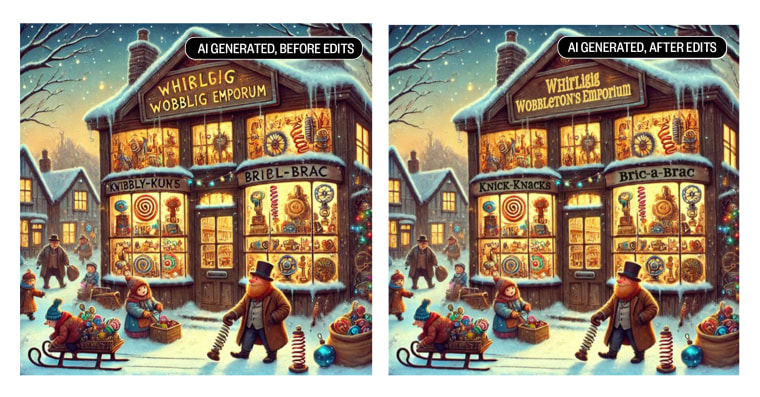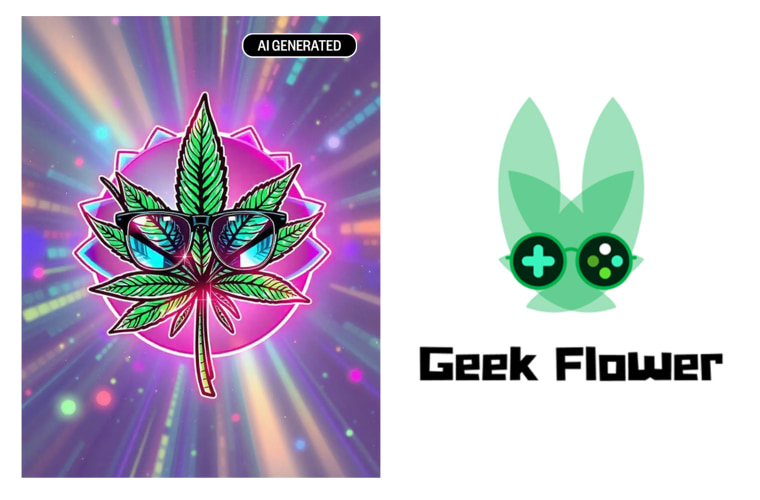The same technology that was supposed to put graphic designer Lisa Carstens out of business is now keeping her busier than ever.
Carstens, a longtime freelancer based in Spain, spends a good portion of her day working with startups and individual clients looking to fix their botched attempts at AI-generated logos.
The illustrations clients bring to her are commonly littered with unclean lines and nonsensical text, and they look like a mess of pixels when blown up beyond a certain size.
“There’s people that are aware AI isn’t perfect, and then there’s people that come to you angry because they didn’t manage to get it done themselves with AI,” Carstens said. “And you kind of have to be empathetic. You don’t want them to feel like idiots. Then you have to fix it.”
Such gigs are part of a new category of work spawned by the generative AI boom that threatened to displace creative jobs across the board: Anyone can now write blog posts, produce a graphic or code an app with a few text prompts, but AI-generated content rarely makes for a satisfactory final product on its own.

The issue has transformed the job market for many gig workers. Despite widespread concern that AI is replacing workers across industries, some are saying they’ve found new work as a result of AI’s incompetencies: Writers are asked to spruce up ChatGPT’s writing. Artists are being hired to patch up wonky AI images. Even software developers are tasked with fixing buggy apps coded by AI assistants.
A recent MIT report found that AI has displaced outsourced workers more than permanent employees. But it also found that 95% of businesses’ generative AI pilots are getting zero return on investment.
“The core barrier to scaling is not infrastructure, regulation, or talent,” the report states. “It is learning. Most GenAI systems do not retain feedback, adapt to context, or improve over time.”
For Carstens, the AI-generated logos clients send her are sometimes well-designed enough that they require only a few fixes on her end. But other times, delivering a quality result requires Carstens to redraw the entire logo from scratch while remaining true to the AI-generated design, which often takes longer than if she were to have come up with a design herself.
Fixing AI’s mistakes is not their ideal line of work, many freelancers say, as it tends to pay less than traditional gigs in their area of expertise. But some say it’s what helps pay the bills.
“That’s all you can do, is learn and adapt,” said freelance writer Kiesha Richardson. “And I have some colleagues who are adamant about not working with AI. But I’m like, ‘I need money. I’m taking it.’”
Richardson, who is based in Georgia, said half of her jobs nowadays come from clients who hire her to tweak or rewrite their AI-generated articles that “don’t look remotely human at all.”

Some of the flaws are easier to correct: AI’s overuse of em dashes, even in places where other punctuation would make more sense, or its clear bias toward words like “embark,” “deep dive” and “delve.” Beyond those quirks, however, Richardson said AI tends to give generic responses that don’t answer questions as thoroughly as a human would, so rewriting an article also requires doing her own research on the topic at hand.
But many clients don’t appreciate the work that goes into revamping a poorly written AI article, she said, noting that companies often offer less pay for these gigs based on the assumption that they’re less demanding. But making AI sound more human can require just as much thinking and creativity as writing the entire article herself, she said.
“I am a bit concerned because people are using AI to cut costs, and one of those costs is my pay,” Richardson said. “But at the same time, they find out that they can’t really do it without humans. They’re not getting the content that they want from AI, so hopefully we’ll stick around a little longer.”
As companies struggle to figure out their approach to AI, recent data provided to NBC News from freelance job platforms Upwork, Freelancer and Fiverr also suggest that demand for various types of creative work surged this year, and that clients are increasingly looking for humans who can work alongside AI technologies without relying on or rejecting them entirely.
Data from Upwork found that although AI is already automating lower-skilled and repetitive tasks, the platform is seeing growing demand for more complex work such as content strategy or creative art direction. And over the past six months, Fiverr said it has seen a 250% boost in demand for niche tasks across web design and book illustration, from “watercolor children story book illustration” to “Shopify website design.”
Similarly, Freelancer saw a surge in demand this year for humans in writing, branding, design and video production, including requests for emotionally engaging content like “heartfelt speeches.”
“I mean, the fastest way to get dumped is to send a love letter to your girlfriend or boyfriend and use ChatGPT to write it,” Matt Barrie, CEO of Freelancer, said of the phenomenon. “And it’s the same thing for brands. The market knows when something has been fully produced by AI, and there’s an immediate visceral reaction to it.”
Brands caught using AI have continued to face backlash from consumers. Last month, Guess sparked outcry online when it featured an AI-generated model in an advertisement that appeared in Vogue.
So even outside of any obvious mistakes made by AI tools, some artists say their clients simply want a human touch to distinguish themselves from the growing pool of AI-generated content online.
To Todd Van Linda, an illustrator and comic artist in Florida, AI art is easily discernible, if not by certain telltale inconsistencies in the details, then by the plasticine effect that defines AI-generated images across a range of styles.
“I can look at a piece and not only tell that it’s AI, I can tell you what descriptor they used to generate it,” Van Linda said. “When it comes to, especially, independent authors, they don’t want anything to do with that because it’s so formulaic, it’s obvious. It’s like they stopped off at Walmart to get a bargain cover for their book.”
Authors come to him, he said, because they know that AI-generated art fails to capture the hyperspecific “vibe” of their individual story. Often, his clients can only give him a rough idea of what they want. It’s then Van Linda’s job to decipher their preferences and create something that draws out the exact feeling each client seeks to evoke from their art.
Van Linda said he also gets approached by people who want him to “fix” their AI-generated art, but he avoids those jobs now because he has realized those clients are typically less willing to pay him what he believes his labor is worth.
“There would be more work involved in fixing those images than there would be in starting from a clean sheet of paper and doing it right, because what they have is a mismatched collection of generalities that really don’t follow what they’re trying to do,” he said. “But they’re trying to wedge the square peg into the round hole because they don’t want to spend any more money.”
The low pay from clients who have already cheaped out on AI tools has affected gig workers across industries, including more technical ones like coding. For India-based web and app developer Harsh Kumar, many of his clients say they had already invested much of their budget in “vibe coding” tools that couldn’t deliver the results they wanted.
But others, he said, are realizing that shelling out for a human developer is worth the headaches saved from trying to get an AI assistant to fix its own “crappy code.” Kumar said his clients often bring him vibe-coded websites or apps that resulted in unstable or wholly unusable systems.
His projects have included fixing an AI-powered support chatbot that gave customers inaccurate answers — and sometimes leaked sensitive system details due to poor safety measures — and rebuilding an AI content recommendation system that frequently crashed, gave irrelevant recommendations and exposed sensitive data.
“AI may increase productivity, but it can’t fully replace humans,” Kumar said. “I’m still confident that humans will be required for long-term projects. At the end of the day, humans were the ones who developed AI.”
Source: https://www.nbcnews.com/




